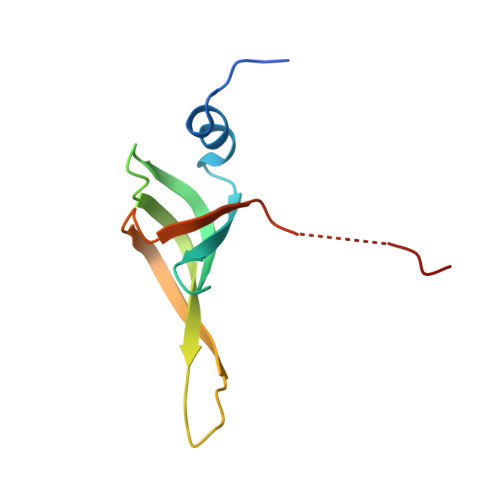Crystal structure of Lsm3 octamer from Saccharomyces cerevisiae: implications for Lsm ring organisation and recruitment
Naidoo, N., Harrop, S.J., Sobti, M., Haynes, P.A., Szymczyna, B.R., Williamson, J.R., Curmi, P.M.G., Mabbutt, B.C.(2008) J Mol Biol 377: 1357-1371
- PubMed: 18329667
- DOI: https://doi.org/10.1016/j.jmb.2008.01.007
- Primary Citation of Related Structures:
3BW1 - PubMed Abstract:
Sm and Sm-like (Lsm) proteins are core components of the ribonucleoprotein complexes essential to key nucleic acid processing events within the eukaryotic cell. They assemble as polyprotein ring scaffolds that have the capacity to bind RNA substrates and other necessary protein factors. The crystal structure of yeast Lsm3 reveals a new organisation of the L/Sm beta-propeller ring, containing eight protein subunits. Little distortion of the characteristic L/Sm fold is required to form the octamer, indicating that the eukaryotic Lsm ring may be more pliable than previously thought. The homomeric Lsm3 octamer is found to successfully recruit Lsm6, Lsm2 and Lsm5 directly from yeast lysate. Our crystal structure shows the C-terminal tail of each Lsm3 subunit to be engaged in connections across rings through specific beta-sheet interactions with elongated loops protruding from neighbouring octamers. While these loops are of distinct length for each Lsm protein and generally comprise low-complexity polar sequences, several Lsm C-termini comprise hydrophobic sequences suitable for beta-sheet interactions. The Lsm3 structure thus provides evidence for protein-protein interactions likely utilised by the highly variable Lsm loops and termini in the recruitment of RNA processing factors to mixed Lsm ring scaffolds. Our coordinates also provide updated homology models for the active Lsm[1-7] and Lsm[2-8] heptameric rings.
Organizational Affiliation:
Department of Chemistry and Biomolecular Sciences, Macquarie University, Sydney, New South Wales 2109, Australia.
















